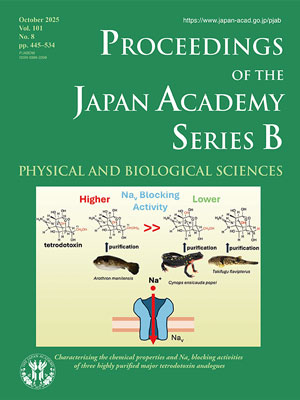About the Cover
Vol. 101 No. 8 (2025)
This original article by Yotsu-Yamashita et al. (in this issue, pp. 519–533) reports the chemical properties and biological activities of three major analogues of tetrodotoxin (TTX), the well-known pufferfish toxin: 4-epiTTX, 11-norTTX-6(S)-ol, and 11-oxoTTX. Among these, 11-norTTX-6(S)-ol and 11-oxoTTX were previously isolated and structurally elucidated by the group led by Dr. Takeshi Yasumoto (Professor Emeritus, Tohoku University; Member of the Japan Academy). TTX is the principal toxin responsible for pufferfish poisoning by blocking voltage-gated sodium channel (Nav), which causes cases of fatal food poisoning in Japan and several other Asian countries where pufferfish is considered a traditional delicacy. More recently, TTX has been detected at low concentrations in commercially important bivalves in Europe, Japan, and some other countries, prompting the European Food Safety Authority (EFSA) to establish regulatory limits for TTX in shellfish. In this context, the biological activities of TTX analogues have attracted particular interest.
In this study, the chemical properties and biological activities of the above analogues were examined using highly purified samples. TTX and its analogues usually exist as a rapidly interconverting equilibrium mixture of hemilactal and 10,7-lactone forms, and the ratios of these forms were determined by NMR spectroscopy. 4-epiTTX was unstable and easily transformed to TTX in physiological conditions. These data will be useful for elucidating the structures of new TTX analogues from both natural sources and synthetic materials in the future. Biological activities of the analogues were evaluated using three methods: inhibition of human Na+ channels (Nav1.2) using whole-cell patch-clamp recording, a colorimetric cell-based assay, and mouse toxicity testing. These evaluations demonstrated that 4-epiTTX and 11-norTTX-6(S)-ol showed lower activity than TTX, whereas 11-oxoTTX displayed activity comparable to TTX. This result was consistent with the previously reported binding model of TTX with Nav1.7 analyzed using cryo-EM (Shen et al., Science, 2019), which suggested that all hydroxy groups in TTX, including 4-OH and 11-OH, are involved in hydrogen bonding with corresponding amino acid residues in the TTX-binding site. The higher activity of 11-oxoTTX may be explained by additional hydrogen bonding of the hydrated aldehyde at C11 with the Nav protein. Because this analogue is present at high concentrations in some pufferfish of the genus Arothron and in edible snails, it warrants particular attention from a food safety perspective.
Toshio Nishikawa
Professor, Graduate School of Bioagricultrural Sciences, Nagoya University




